2021-2022 Flight Training Experience Awards
Difference makers
Learning to fly isn’t just about mastering landings, memorizing regulations, or reciting mnemonics in your sleep. It’s about challenging yourself to do things you may not have thought possible, thinking in new ways, honing your decision-making skills, and unlocking a world of adventure with like-minded people. So, the best instructors and flight schools aren’t just conveyors of knowledge, they’re trusted guides. In 2021, we asked anyone who received flight instruction in the past year to tell us about their experience and the factors that matter most in flight training: educational quality, customer focus, community, and information sharing. These schools and instructors were the best of the best, based on your feedback. On these pages we introduce the 2021-2022 Flight Training Experience Award winners.
Best Flight School
National Best Flight School/Central Southwest Regional
In the Pattern, Denton, Texas


No regrets
In the Pattern fosters an aviation community
By Ian J. Twombly
It’s all about community. Other schools may have newer airplanes, a longer history, or even lower prices, but owner Sherman Gardner said at In the Pattern, customers will be joining a group of people who truly care about them.
In the Pattern started somewhat by accident in the summer of 2019. Gardner and his brother began by renting their personal airplane to a friend. Seeing that it was helpful to the friend, and provided some additional income, they decided to expand, and purchased another airplane. “People kept coming to us wanting to learn,” Gardner said. “I fought it because I didn’t want to become a flight school, but I have no regrets now.”
A scant three years after the business began, and two years after the school opened, they have 12 airplanes, seven instructors, and rave reviews.
Gardner desires to treat ITP’s customers not as sources of revenue, but as people. It’s a philosophy that began with his ministry work, and it continues to serve him well in business. “Working in ministry all those years, all I did was serve people,” he said. “I work real hard to make sure there’s a good strong relationship experience with our customers and our team.”
This focus is evident in frequent community events, impromptu staff gatherings around a free lunch, yearly planning sessions with the instructors, and in how Gardner and the staff treat customers each day. “We grow the community of acceptance. When people come in the door we know their names, we know what they do for a living, we know about their family. It’s more about the experience for us.” The school’s motto is “Experience Aviation.” It’s a nod to the fact that you can get a pilot certificate anywhere, but at ITP it will become a richer experience.

Right at home
Want sterile? Air Ventures Flying School isn’t about that
BY Jill W. Tallman
If you want to learn to fly, thousands of flight schools can teach you that. But if you want to learn to be a pilot, consider training at Air Ventures Flying School in Pawtucket, Rhode Island.
Air Ventures Flying School, located at the North Central State Airport (SFZ) in Smithfield, Rhode Island, isn’t going to sell you your next rating while you’re still working on your first, said owner and chief flight instructor Doug Auclair. “My objective is to sell training, but over a 30-year period instead of a two-year period,” he said.
Auclair launched Air Ventures in 2010 with $800 in his pocket and an airplane on leaseback. Today the flight school has a fleet of four airplanes it owns, a flight simulator, and eight full-time employees.
Air Ventures offers a warm and welcoming environment in which customers are encouraged to hang out, ask questions, and watch airplanes. The flight school fosters community through such events as an annual chili cookoff, a summer luau, flyouts to Martha’s Vineyard, and a yearly pilgrimage to EAA AirVenture in Oshkosh, Wisconsin.
“We build pilots to be pilots so they can succeed as a pilot in the long term,” Auclair said. This means teaching customers to fuel airplanes, arrange overnight parking at remote locations, and even how to hangar or move an airplane by yourself. “It takes the anxiety away when you’re out in the world,” said Auclair.

Treating customers right
Blue Skies Flying Services is all about the customer
By David Tulis
Mike Carzoli opened Blue Skies Flying Services 28 years ago to provide a fun, family-oriented, and professional flight training environment at Lake in the Hills Airport west of Chicago, and the philosophy has paid off.
“It’s really all about the customers that walk in the door,” Carzoli said. “I try to bring in people that know how to treat others right.” Blue Skies traditionally throws down a welcome mat during an annual cookout, and the facility also supports veterans and the EAA Young Eagles program. “We try to stay involved as much as we can in the Lake in the Hills community,” he said.
“We got these little two-person hot dog tables scattered about and people just come and sit down and shoot the breeze,” said Carzoli. “Sometimes it’s old-timers and students, sometimes it’s instructors, or people just visiting the pilot shop. I mean, unless it’s pouring rain or a blizzard out, there are people here just hanging out.”
The school employs 16 to 17 full- and part-time instructors, and Carzoli’s daughter is the office manager. Students train in six Piper Warriors, two Piper Archers, a Piper Arrow, and a couple of Cessna 172 Skyhawks.
“Just this morning, three or four of us were talking about how different students were doing and what we needed to do” to keep them on track, said Chief Flight Instructor Mike Biewenga (above right, with Carzoli) “There’s a lot of heart that goes into it [because] we really care about their progress.”
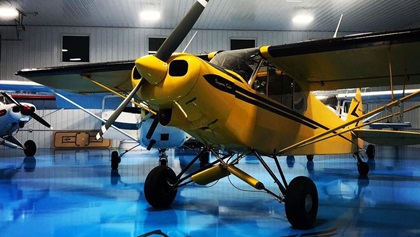
Come as clients, leave as friends
Ridgeline Aviation fosters more than learning
By Ian J. Twombly
Grayson Sperry is something of an overachiever. While finishing a chemical engineering degree in four years at Montana State University he also earned all his pilot certificates up through flight instructor. After a few years working in his field, he bought an airplane, quit his job, and started a flight school. Four years later, his flight school occupies 15,000 square feet in Bozeman, Montana, has a second location in Billings, and operates multiple airplanes on a charter certificate.
Sperry started by offering advanced instruction in his Cessna turbo 182RG. “That first winter we didn’t make any money,” he said. By spring he was flying only 10 hours a month, but word traveled fast. By the end of June, the first year he was flying nearly 100 hours a month, and soon hired Mitch Edwards to be chief instructor. “From there it’s been grow as fast as you can.”
Sperry estimates that half of the school’s CFIs have been its students at some point. Although the school uses the Jeppesen syllabus and is Part 141 certified, which requires a structured curriculum, he said the school gives instructors leeway to provide the type of instruction that best fits their personality.
Then it’s all about transparency, honesty, and making students feel like they are part of the family. They take family vacations together, and students are invited to fly into the backcountry with instructors on camping trips. “They walk in as clients, but 90 percent leave as good friends,” Sperry said.
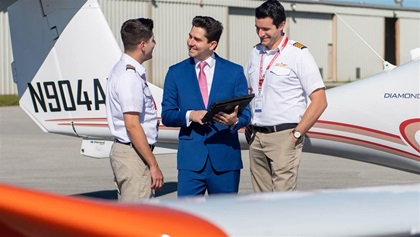
‘Little fish in a big pond’
Miami school offers encouragement, customer service
By David Tulis
Aviator Zone Academy flight school founder Felipe Santiago was 12 years old when he decided to pursue an aviation career. Santiago’s family didn’t have much money, but he possessed two important traits: drive and ambition. The son of Cuban immigrants landed a summer job at the flight school washing airplanes, answering the telephone, and helping schedule flights, and did “whatever I could to trade for flight time in a Cessna 150. That kind of started everything.”
Santiago founded the flight school at Miami Executive Airport—a competitive training environment with a half-dozen schools—in 2018 with one airplane and one instructor. He compared it to being a small fish in a big pond, “but we weren’t even a small fish, we were like a tadpole.” But the school kept growing. “It’s amazing what happens when you deliver a good service, a good product, and treat people well,” he said. Now 27, Santiago employs six instructors, two dispatchers, and a maintenance technician, and operates seven flight training aircraft.
Santiago is also a captain for a major airline, but he said general aviation remains his first love. “If you ask me if I want to take the Airbus or fly around in a [Piper] Cub, I’ll take the Cub anytime.”
If he sees students hit a plateau, get frustrated, or become disappointed, he says he puts himself in their shoes to keep them motivated. “I’ll say, ‘Look, you’re going to be able to do this, you’re going to push through.’ And then once they do, it’s very rewarding.”

More flying, less wrenching
Sierra Charlie Aviation goes with a new fleet
By Ian J. Twombly
If the name Sierra Charlie Aviation sounds familiar there’s good reason for it. The school, which began in Scottsdale and now has a second location in Chandler, Arizona, has become something of a regular on this list.
Repeating as Best Flight School in a region can be a challenge, but doing it while continuing to grow at such a fast rate is virtually unheard of. Today Sierra Charlie has more than 30 flight instructors and more than 10 airplanes. One of the key aspects of the school is that fleet, which is compromised primarily of late-model Cessna 172s with Garmin G1000 panels. This doesn’t make for the cheapest flight training around, but owner Scott Campbell thinks there are significant upsides to using newer airplanes. Multiple reviews mention the airplanes, so it’s clear that customers appreciate them. And Campbell told AOPA’s Flight School Business that having an identical fleet means students don’t choose favorites. So having an airplane that goes down for a day doesn’t necessarily lead to a student cancellation.
Most schools that shy away from new airplanes do it because they assume the higher acquisition costs make them untenable. Yet Campbell thinks the reduction in downtime increases revenue, and the lack of maintenance headaches enables him to better focus on other parts of the business. For students, it all comes down to value. New may cost more, but you’re getting a lot more for your money. A younger, tech-savvy clientele demands modern avionics and better reliability, and at Sierra Charlie Aviation that’s exactly what they’re getting.
Distinguished Flight Schools by Region
|
Central Southwest Eastern |
Great Lakes Northwest Mountain Southern |
Western Pacific |
Best CFI
National Best Flight Instructor/Great Lakes Region
Ambyr Peterson Minneapolis, Minnesota


Helping dreams come true
Second career returns pilot to her passion
By Jill W. Tallman
Ambyr Peterson is four years into her second career as a certificated flight instructor, and the Michigan native said her reason for loving what she does might sound cliché—but it’s true.
“I love helping people’s dreams come true,” Peterson said. “Every single person that walks through your door wants to be there and wants to fulfill this passion.”
Her first career, as a program manager involved with quality procurement and engineering for Israel Aerospace Industries, was aviation-related but was not a passion. Peterson had earned a private pilot certificate in high school because she wanted to become an astronaut. She flew intermittently for a few years, but she couldn’t afford to continue.
In 2015 a friend who flew for NetJets suggested Peterson get back into the cockpit, and she did. “The same passion was there,” she said. She quickly acquired instrument, commercial, and certificated flight instructor rating and certificates and settled into the rhythm of flight instructing. At Inflight Pilot Training in Minneapolis, where Peterson is assistant chief flight instructor, she has gained a reputation as the CFI to see when a student has encountered a learning plateau. She also enjoys helping flight instructors excel at teaching—which does not come naturally to everyone who finds themselves flight instructing to build hours.
Her most challenging student? “An instrument student who truly isn’t getting it,” Peterson said. “There’s not a lot of creativity that you’re allowed to do with instrument flying; it is what it is, and you have to make decisions very quickly.”

Winding road to recognition
Steve Fairbanks credits mentors, flying community
By David Tulis
Steve Fairbanks began flight lessons in the late 1990s, earned his private pilot certificate just prior to the September 11, 2001, attacks, and then didn’t fly again for about 18 years. Once he rededicated his energy to flight training in 2019, he quickly progressed from private pilot to CFI with multiengine and instrument instructor ratings.
Fairbanks teaches at Code 1 Flight Training at Van Zandt County Regional Airport near Dallas. He said providing a welcoming flight training environment includes networking, airport cookouts, and other aviation events that break down barriers and help make flying more accessible.
Fairbanks said adapting to a student’s learning environment helps them better absorb what it takes to earn a pilot certificate or rating. “Trying to get a feel for the individual, talking to them about their goals within aviation, and then making sure we reach their expectations” help keep the teacher and the student focused, he said.
Fairbanks has recently added corporate flying assignments in an Embraer Phenom 300 to his skill set; the jet-flying experience allows him to bring real-world commercial flying insights to his students.
“Look, I get the best office view out of the front windscreen, I get to meet a variety of different, new, and interesting people, and I get to help them reach their aviation goals. With all of that combined—every day is a great day in aviation for me.”
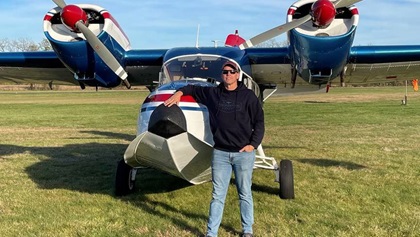
Love of learning
CFI David Strassburg remembers what it’s like to be a student
By Jill W. Tallman
David Strassburg has no illusions about being a super pilot: Even though he has an airline transport pilot certificate, he enjoys the process of continual learning.
“I liked being a student. I like learning,” said Strassburg, who instructs at Northampton Aeronautics at Northampton Airport in Massachusetts.
Strassburg learned to fly at age 19, and he came to flight instruction after working in the pharmaceutical industry and launching a medical device company with his father. He’s transitioned from that business to full-time flight instruction, and he loves it.
Strassburg has carved an unusual niche for himself in general aviation: He concentrates on accelerated multiengine training, with glider training occupying a lot of his time when the season permits it. He jokes that he “covers everything non-single-engine.”
Strassburg believes that each flight lesson should have a purpose. “You have to have a mission to make the most of [students’] time,” he said.
He’s also a believer in using flight simulators. Northampton Aeronautics has a Redbird flight simulator that Strassburg rigged with a camera so that he can watch a student go through a maneuver. He also uses it for multiengine training, and he built a portable cockpit to use with the Condor flight sim program for glider training.
His students say Strassburg excels at recognizing a student’s strengths, weaknesses, and learning style, and tailoring his teaching style accordingly. “You have to tell [students] what they’re doing right,” he said.
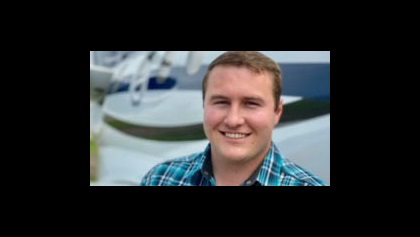
Confidence builder
Jess Padden of Summit Aviation invests in student success
By Lillian Geil
Aviation instruction demands a thorough commitment, but you don’t need to tell that to Jess Padden, who goes above and beyond to make sure his students feel confident, both in the air and on the ground.
Padden earned all his certificates at Summit Aviation in Bozeman, Montana. He started instructing at Summit Aviation in 2018, worked his way up to chief instructor, and is now a charter pilot for the company—flying as second in command in an Embraer Phenom 300.
In the cockpit, Padden balances each lesson with challenging but attainable goals. He mentions how important it is to read the physical and emotional cues of the student and adjust accordingly, making the lesson individual to each student.
On the ground, Padden provides sweeping support to the organization, taking initiative to ensure the available training is comprehensive and accessible. “The training materials were basic and there were gaps,” he said. Padden rewrote the training supplements, compiling information from a few sources to make it easier for students to find answers to their questions. After implementation he saw measurable differences. For example, his multiengine private add-on students went from an average of certification in 20 flight hours to certification in 10 to 15 flight hours.
Padden fosters confidence among his students with an emphasis on acknowledging milestones—big and small. “I think that instructors truly need to understand that you are creating the foundation of knowledge and skill for new aviators.” Padden said. “Set short-term goals with them so that each ‘little’ achievement keeps the student engaged.”
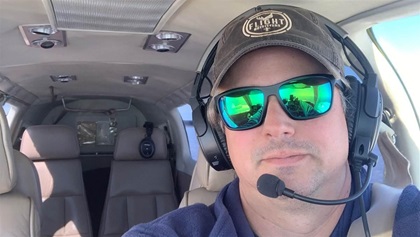
Mission focused
Matt Eichel prepares military pilots for airline careers
By Dave Hirschman
Matt Eichel knows how to get through to pilots.
As a U.S. Air Force weapons system officer flying in the back seat of McDonnell-Douglas F–15E Strike Eagles, he closely coordinated his actions with the pilot and other team members—often in strenuous, stressful situations.
Now, after 13 years in the military, Eichel is helping fellow veterans prepare for airline flying careers at MIL2ATP, a flight school in Goldsboro, North Carolina.
“We know how to help military pilots make the transition to civilian airline flying,” said Eichel, 39, a certificated flight instructor who has earned instrument instructor and multiengine instructor ratings. “We concentrate on the new material they need to learn, and we don’t rehash the things they already know so they can meet their professional goals as quickly and efficiently as possible.”
In addition to the academic, simulator, and flight training required for civilian airline transport pilot certificates, MIL2ATP provides airline networking, résumé writing, and interview preparation courses.
MIL2ATP’s structured training allows students to meet their goals while also having fun.
“Flight training should never be a laborious chore,” Eichel said. “You’ve got to teach the book knowledge, but you should do it in a way that makes it fun and enjoyable. If that means flying to the beach or stopping somewhere for a burger, that’s OK. I do my best to lighten up and have some fun whenever the situation allows.”
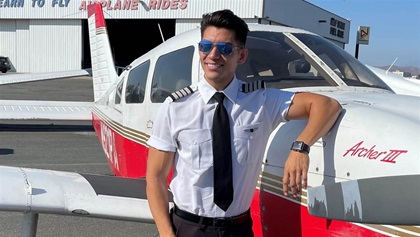
Discovering a talent for teaching
Sergio Ramirez puts students first
By Dave Hirschman
Flight instructing was a steppingstone for Sergio Ramirez on the way to becoming an airline pilot. But he discovered along the way that he has a talent for teaching and enjoys seeing his students accomplish their own flying goals.
“Flight instructing was something I believe came very natural to me,” said Ramirez, who obtained his CFI certificate at AeroGuard Flight Training Center in Temecula, California, and then taught there before landing a job as a pilot for a regional airline. “As a flight instructor, I simply translated to my students what techniques and ideas worked best for me.”
Ramirez said he was always interested in aviation but thought airline pilot careers were reserved for former military pilots. He looked into becoming a flight attendant, and it was only then that he realized a career as a pilot was a possibility. Ramirez intends to return to flight instructing at his airline as an evaluator of fellow professional pilots, or as a sideline to his airline career.
One of his former students praised Ramirez for instilling pride, helping the student look beyond the next test and the next checkride, and making the process enjoyable.
“He gave me confidence that I was being trained first and foremost to be a good pilot, not just a good test-taker,” the student wrote in recommending Ramirez for a Flight Training Experience Award. “Sergio knows a healthy balance between emphasizing how serious one should take their piloting skills, but never lost the ability to impress upon us how wondrous and special what we get to do is. He kept it fun.”
Distinguished Flight Instructors by Region
|
Central Southwest
Eastern |
Great Lakes Northwest Mountain |
Southern Western Pacific |


